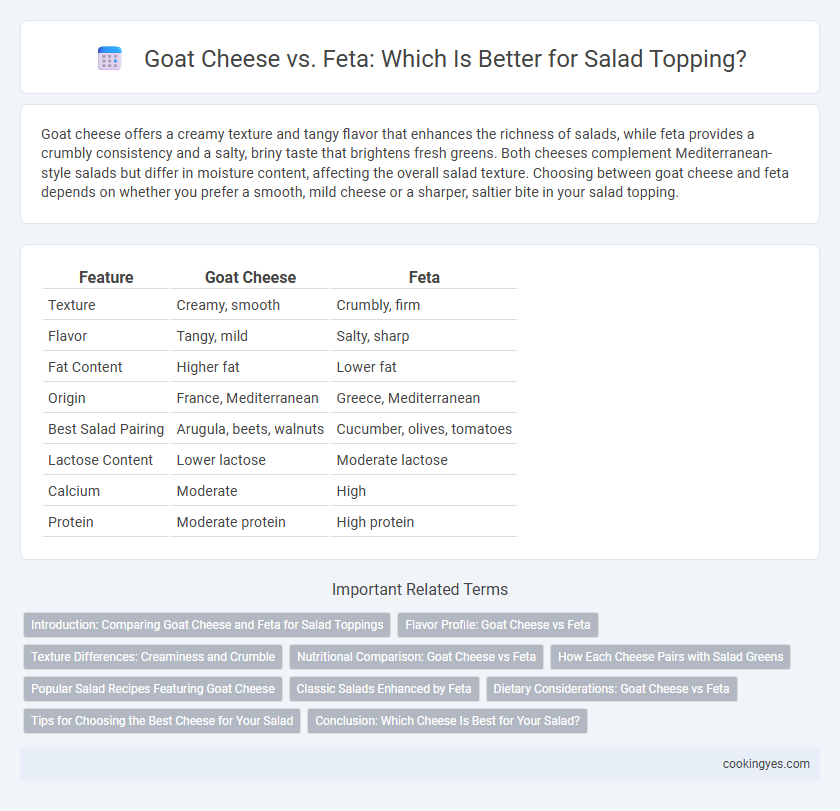Goat cheese offers a creamy texture and tangy flavor that enhances the richness of salads, while feta provides a crumbly consistency and a salty, briny taste that brightens fresh greens. Both cheeses complement Mediterranean-style salads but differ in moisture content, affecting the overall salad texture. Choosing between goat cheese and feta depends on whether you prefer a smooth, mild cheese or a sharper, saltier bite in your salad topping.
Table of Comparison
| Feature | Goat Cheese | Feta |
|---|---|---|
| Texture | Creamy, smooth | Crumbly, firm |
| Flavor | Tangy, mild | Salty, sharp |
| Fat Content | Higher fat | Lower fat |
| Origin | France, Mediterranean | Greece, Mediterranean |
| Best Salad Pairing | Arugula, beets, walnuts | Cucumber, olives, tomatoes |
| Lactose Content | Lower lactose | Moderate lactose |
| Calcium | Moderate | High |
| Protein | Moderate protein | High protein |
Introduction: Comparing Goat Cheese and Feta for Salad Toppings
Goat cheese and feta are popular salad toppings that offer distinct flavors and textures, enhancing the overall taste profile of salads. Goat cheese has a creamy, tangy flavor with a smooth consistency, while feta is crumbly, salty, and briny, often made from sheep's milk or a blend of sheep and goat milk. Selecting between goat cheese and feta depends on the desired salad flavor intensity and texture, with goat cheese lending a richer creaminess and feta providing a sharp, crumbly contrast.
Flavor Profile: Goat Cheese vs Feta
Goat cheese offers a creamy texture with a tangy, earthy flavor that adds richness to salads, while feta provides a crumbly texture and a sharp, salty taste derived from sheep's milk or a mix with goat's milk. The mild tartness of goat cheese complements fresh greens and fruits, whereas feta's briny notes enhance Mediterranean-style salads with olives and cucumbers. Choosing between goat cheese and feta depends on the desired balance between smooth creaminess and pronounced saltiness in your salad topping.
Texture Differences: Creaminess and Crumble
Goat cheese offers a creamy, smooth texture that melts slightly over warm salad greens, adding a rich, velvety mouthfeel. In contrast, feta is crumbly and dry, providing a sharp, briny bite with a grainier consistency that enhances salad freshness. The choice between goat cheese and feta depends on whether a salad benefits more from creamy richness or a tangy, textured crumble.
Nutritional Comparison: Goat Cheese vs Feta
Goat cheese contains approximately 103 calories and 6 grams of fat per ounce, with higher levels of vitamin A and calcium compared to feta. Feta cheese has around 75 calories and 6 grams of fat per ounce, offering more sodium and a distinct tangy flavor due to its brine curing. Both cheeses provide protein and probiotics beneficial for gut health, but goat cheese is generally lower in sodium, making it a better option for low-sodium salads.
How Each Cheese Pairs with Salad Greens
Goat cheese offers a creamy, tangy flavor that complements peppery arugula and bitter radicchio, enhancing their natural sharpness. Feta provides a salty, crumbly texture that pairs well with crisp romaine and sweet cherry tomatoes, balancing freshness with a briny depth. Both cheeses bring distinct taste profiles that elevate salad greens through their unique contrasts and textures.
Popular Salad Recipes Featuring Goat Cheese
Goat cheese enhances salads with its creamy texture and tangy flavor, making it a perfect topping for popular recipes like beet and arugula salad or spinach and walnut salad. Its smooth consistency contrasts well with crisp greens and sweet fruits, creating a balanced taste profile. Many Mediterranean-inspired salads incorporate goat cheese to add richness and a distinctive savory note.
Classic Salads Enhanced by Feta
Feta cheese enhances classic salads like Greek salad with its tangy, salty flavor and crumbly texture, perfectly complementing fresh vegetables and olives. Unlike goat cheese, feta maintains its firmness and distinct bite even when mixed with vinaigrettes, ensuring each salad bite is flavorful. Its higher salt content and brined curing process provide a robust taste that elevates Mediterranean-inspired salad recipes.
Dietary Considerations: Goat Cheese vs Feta
Goat cheese offers lower lactose content and higher digestibility, making it a preferred choice for those with mild lactose intolerance, whereas feta contains more salt and can be higher in sodium, which may concern individuals monitoring their salt intake. Both cheeses provide valuable protein and calcium, but goat cheese typically contains more healthy fats like medium-chain triglycerides that may aid metabolism. For ketogenic or low-carbohydrate diets, goat cheese is often favored due to its creamier texture and lower carbohydrate content compared to traditional feta.
Tips for Choosing the Best Cheese for Your Salad
Choose goat cheese for salads when seeking a creamy, tangy flavor that pairs well with sweet ingredients like beets or berries. Opt for feta cheese to add a salty, crumbly texture that complements Mediterranean vegetables and olives. Consider the salad's overall flavor profile and texture preferences to select the ideal cheese that enhances freshness and balances acidity.
Conclusion: Which Cheese Is Best for Your Salad?
Goat cheese offers a creamy texture and tangy flavor that complements fresh greens and roasted vegetables, making it ideal for salads aiming for a rich, smooth taste. Feta provides a saltier, crumbly profile with Mediterranean notes, perfect for adding a bold, briny contrast to crisp veggies and olives. Choosing between goat cheese and feta depends on your salad's flavor balance and texture preference, as goat cheese enhances creaminess while feta brings a sharper, crumbly bite.
Goat Cheese vs Feta for Salad Topping Infographic

 cookingyes.com
cookingyes.com